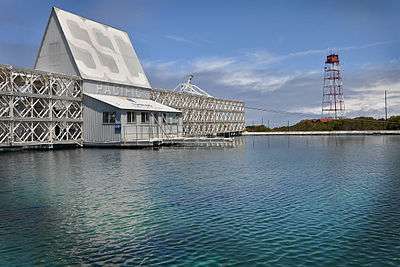Space and Naval Warfare Systems Center Pacific

Space and Naval Warfare Systems Center Pacific (SPAWAR Systems Center Pacific or SSC Pacific) provides the Navy with research, development, delivery and support of integrated command, control, communications, computers, intelligence, surveillance, and reconnaissance (C4ISR), cyber and space systems and capabilities across all warfighting domains. The only Naval technical center headquartered in a major fleet concentration area, SSC Pacific manages strategic locations both in the Pacific theater and around the world. The diverse, multi-disciplinary workforce of more than 4,175 scientists, engineers and support personnel work hand-in-hand with more than 200 Fleet operators and active duty service members to ensure SSC Pacific solutions are Fleet-and warfighter-ready.
With expertise in network architecture and system design, SSC Pacific is leading the design and deployment of the Consolidated Afloat Networks and Enterprise Services (CANES) program --- the single largest, most complex upgrade to C4I cyber systems in U.S. Navy history. The Center's numerous unique facilities, test beds and experimentation platforms serve as the launching pad for game-changing innovations.
SSC Pacific is advancing the Navy's employment of next generation unmanned systems and autonomous vehicles, large data management, antenna design, clean and renewable energy sources, and both offensive and defensive cyber programs. As the primary research arm of the Space and Naval Warfare Systems Command (SPAWAR), SSC Pacific supports basic research and prototype development, basic and applied science, extensive test and evaluation services, systems engineering and integration, installation and full spectrum life-cycle support of fielded systems. With world-wide connectivity and numerous partnerships with private industry and academia, SSC Pacific addresses warfighting requirements for Navy, Joint, National and Coalition war fighters.
History
On June 1, 1940, Secretary of the Navy Frank Knox established the Navy’s first laboratory on the West Coast, the U.S. Navy Radio and Sound Laboratory. Its mission was to perform research and development in communications and radio propagation. In 1943, a second West Coast laboratory was established in the high desert at Inyokern, Calif., the Naval Ordnance Test Station (NOTS), charged with improving naval weapons systems, particularly those dropped from aircraft.[1]
Over the next several decades, those two organizations changed names several times: the U.S. Navy Radio and Sound Lab became the U.S. Navy Electronics Laboratory, the Naval Command Control and Communications Laboratory Center, and the Naval Electronics Laboratory Center (NELC); while NOTS became the Naval Undersea Warfare Center, the Naval Undersea Research and Development Center, and the Naval Undersea Center (NUC). On March 1, 1977, NELC and NUC were consolidated to form the Naval Ocean Systems Center (NOSC).[1]
During 30-plus years, these Navy research, development, test and evaluation (RDT&E) organizations specialized in command, control and communications (C3); Arctic submarine warfare; undersea weapons systems; intelligence and undersea surveillance technology, as well as a number of other important areas including lasers, underwater vehicles, environmental science, high performance computing, robotics and marine mammal research.[1]
The merger was intended to produce broad-spectrum systems capability; facilitate integration of intelligence, ocean surveillance, C3 and undersea weapons in support of the Navy’s sea control mission; and combine research and technology programs to increase flexibility and generate more funding for broader and more in-depth investigation.[1]
During the 1990s, NOSC was renamed following several Base Closure and Realignment Commission (BRAC) actions starting with the Naval Command, Control and Ocean Surveillance Center (NCCOSC) RDT&E Division, then the Space and Naval Warfare Systems Center San Diego; also added were a number of other Navy commands, including the NCCOSC In-Service Engineering West Coast Division; and some substantive changes in business areas, including the loss of leadership roles in anti-submarine warfare weapons systems and Arctic submarine warfare, and the gain of in-service engineering functions and navigation technology. In late 2008, the organization was assigned its current name, the Space and Naval Warfare Systems Center Pacific (SSC Pacific).[1]
During its more than seven decades in operation, SSC Pacific has been responsible for ground-breaking achievements in its mission areas, past and present.[2]
SPAWAR San Diego

In 1997, the San Diego facility became the headquarters of the Navy's Space and Naval Warfare Systems Command (SPAWAR), formerly located in the Washington, D.C. area.[3] SPAWAR and its systems centers provide much of the tactical and non-tactical information management technology required by the Navy to complete its operational missions. SSC Pacific is one of five field activities of SPAWAR. The other four SPAWAR activities are Space and Naval Warfare Systems Center Charleston, Space and Naval Warfare Systems Center Norfolk, Information Technology Center New Orleans and Space Field Activity.
SPAWAR San Diego Ca is registered as an active superfund site by the EPA. It is not on the National Priorities List, which means the EPA does not consider it one of the nation's most hazardous waste sites.
In September 2014, more than 150 employees in the public affairs and engineering departments of San Diego's SPAWAR facility in Old Town had to be moved to avoid toxic trichloroethylene (TCE) vapors. Soil and groundwater beneath the Naval site is contaminated with byproducts from World War II era missile and aircraft production. TCE is a volatile metal-cleaning agent. Since 2011, the Navy has been removing toxic waste, which has reduced TCE levels beneath the building. The Navy plans to complete its cleanup by 2018.[4]
Mission
SSC's mission is to enable Naval, Joint, National, and Coalition war fighters with information dominance through research, development, delivery, and support of integrated capabilities. Compared to other like sectors, SSC Pacific typically ranks in the top ten organizations for new patents filed annually in San Diego.[5]
For more than 70 years, the U.S. Navy has relied on SSC Pacific for research and development of C4ISR products and services. Aside from their military purpose, these information technologies also have applications in disaster relief, crisis response, emergency management, and other civilian operations where dynamic communications, collaboration, and situational awareness are essential to protecting lives and property.
Leadership areas
SSC leads in the following areas[6]
- Command, control and communications systems
- Command, control and communications systems countermeasures
- Ocean surveillance systems
- Command, control and communications modeling and analysis
- Ocean engineering
- Navigation support
- Marine mammal operational systems
- Integration of space communications and surveillance
In addition, SSC Pacific is involved in complementary areas of research including[7]
- Ocean and littoral surveillance
- Microelectronics
- Communications and networking
- Ship topside design/antennas
- Command systems
- Computer technology
- Navigation and aircraft C3
- Intelligence/surveillance/reconnaissance sensors
- Atmospheric effects assessment
- Environmental quality assessment
Major initiatives
SSC Pacific’s major initiatives are[8]
- Enhanced Polar System (EPS)
- Enterprise Networks
- Cyber—including Cyber Security
- Mobile User Objective System (MUOS)
- C4ISR for UxVs—Autonomy
- Support to the Warfighter
- Networking on the Move
- Military Construction for (MILCON) C4I
- Unmanned Underwater Vehicles (UUV)
- Commander, Seventh Fleet (C7F)
- Consolidated Afloat Networks and Enterprise Services (CANES)
Integrated cyber operations are a key focus area for SSC Pacific to "enable U.S. forces to maneuver in the cyber domain while denying our adversary’s ability to do the same." Cyber operations "involve a close coupling of computer network defense, computer network exploitation, and computer network attack development and engineering."
SSC Pacific is located close to major operational commands of air, surface, submarine, and special operations Naval forces, as well as air, expeditionary, and electronic components of the U.S. Marine Corps. This support extends into the Pacific, with a SPAWAR Systems Activity in Hawaii supporting U.S. Pacific Command (PACOM) and U.S. Pacific Fleet (PACFLT), as well as facilities in Guam and Japan supporting U.S. Seventh Fleet (C7F).
San Diego K-12 education outreach events
In support of the next generation of science, technology, engineering, and mathematics (STEM) professionals, SSC Pacific hosts a variety of K-12 education outreach events including: classroom demonstrations and presentations, international robotics competitions, community events, science fairs and festivals, internships, and mentorship activities. SSC Pacific is engaged with local colleges and universities offering research and academic partnerships, and student employment programs, such as the San Diego State University Research Foundation program.[9]
Other activities
SSC Pacific has been the host of the Association for Unmanned Vehicle Systems International annual Autonomous Underwater Vehicle competition since 2002.
References
- 1 2 3 4 5 "SSC Pacific Celebrating 70th Anniversary in 2010," SSC Pacific Daily News Bulletin, Sept. 4, 2014.
- ↑ {Maritime Museum of San Diego; Mains 'L Haul, a Journal of Pacific Maritime History; Vol. 50, 2014.]
- ↑ GlobalSecurity.org
- ↑ Joel Hoffmann (2 October 2014). "SPAWAR workers relocated due to fumes". San Diego Tribune. Retrieved 3 September 2015.
- ↑ [San Diego Military Advisory Council, 5th Annual SDMAC Military Economic Impact Study, San Diego Region, 2013, San Diego, Calif.: San Diego Military Advisory Council, 2013, http://www.sdmac.org/ImpactStudy.htm.]
- ↑ [“SSC Pacific: Organization Information,” on the SPAWAR public website, accessed September 8, 2014, http://www.public.navy.mil/spawar/Pacific/Pages/OrganizationInfo.aspx.]
- ↑ ["SSC Pacific: Organization Information."]
- ↑ ["Space and naval Warfare Systems Command, Systems Center Pacific, NDIA Exec Forum, 13 May 2014," on the SPAWAR public website, accessed September 4, 2014, http://www.public.navy.mil/spawar/Press/Pages/05132014_ED_NDIA.aspx.]
- ↑ [San Diego Military Advisory Council, 5th Annual SDMAC Military Economic Impact Study.]
External links
| Wikimedia Commons has media related to Space and Naval Warfare Systems Center Pacific. |
Coordinates: 32°44′57″N 117°11′50″W / 32.74917°N 117.19722°W
